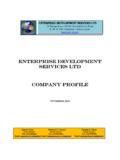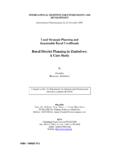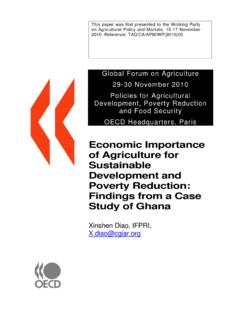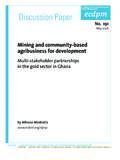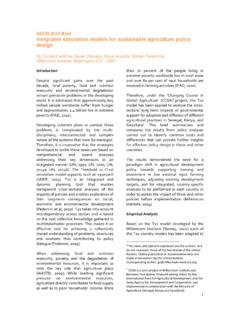Transcription of Ghana Situation analySiS - IWMI
1 Ghana Situation analySiSIntroductionThis Situation analySiS covers all regions of Ghana and is based on secondary data, field observations, household interviews in selected locations and interviews with key results of the Situation analySiS are summarized here concentrating on existing environmental, social and political conditions across Ghana as well as on the agricultural water management (AWM) solutions currently in use and those that have potential to improve agricultural production and farmers livelihoods. The AWM solutions described were shared at the National Consultation Workshop and priority solutions were selected by participants. For more on this workshop, please see the National Consultation Workshop Brief which is also available on the ContextAgriculture contributes about 37% of GDP in Ghana and employs 56% of the economically active population. Approximately million households are involved in farming, and smallholder farms account for about 80% of the total agricultural output.
2 Only about 38% of agricultural land in Ghana is cultivated and productivity is generally low. Ghana is endowed with sufficient water resources, and estimates of Ghana s irrigation potential range from to million ha depending on the degree of water control. However, the country faces significant variability in water resources, both spatially and temporally, such as periodic floods and droughts, and uneven distribution of annual precipitation that, on average, is billion m3/year. The dependence on rainfed agriculture, particularly in the north, means that even though production of the major staple food crops is adequate in most years, seasonal food insecurity is is drained by the Volta, Southwestern and Coastal River systems, with a mean annual runoff of billion m3 that, if adequately managed, is enough to support most domestic and irrigation uses. In 2000, about 652 million m3 of water was used for irrigation, approximately 66% of total withdrawals.
3 Ghana also has over 56,000 groundwater abstraction systems (Kortatsi et al. 1995) but its use is still less than 5% of the average annual groundwater recharge in most of the SolutionsThe irrigation system typologies observed in Ghana may broadly be classified into two groups based on their current level of formalization. These are: Emerging irrigation systems, which are initiated and developed by private entrepreneurs and farmers, either autonomously or with limited support from government or NGOs. These systems are expanding due to access to pumping technologies and export markets; and Conventional systems, which are mainly surface irrigation schemes initiated and developed by the government or Irrigation Systems Emerging systems are diverse but mainly rely on the use of small pumps. The systems are usually privately owned but may be communally managed or part of partnerships with the private sector. Shallow Groundwater IrrigationShallow groundwater is tapped for irrigation, using hand-dug wells, wherever it is available.
4 Groundwater is Ag r i c u l t u ra l Wa te r M a n a g e m e n t N a t i o n a l S i t ua t i o n A n a l y s i s B r i e fjanuary briefing note is a summary of the Situation analySiS conducted in Ghana in 2009-2010. The analySiS reviewed existing agricultural water management practices and the conditions within which they took place. mainly used to grow vegetables in the dry season, which provides considerable income even on small land areas. Different versions or sub-typologies of shallow groundwater irrigation systems were observed during the field surveys. Seasonal shallow wells range in depth from 1 to 5 m depending on the water table and the water lifting technology used. A well can be dug by one person in approximately 4 hours at a cost of around GH 55/year. It can serve plots within a 50 m radius. Water is collected from the wells using motorized pumps, hand pumps, treadle pumps, or ropes and buckets. Wells are usually used by farmers in low-lying areas with high water tables, often along river banks, on riverbeds and in swampy areas.
5 They may also be used close to poorly functioning formal irrigation schemes, where seepage water can be tapped. Examples of this are Busa in the Upper West (UW) Region, and Bugri, Kugri and Telania in the Upper East (UE) Region. At Telania, farmers pay fees to the water user association (WUA) for the shallow wells are used throughout the year for vegetables, domestic purposes and livestock. Farmers prefer cement-lined wells but some do not have the financial means to acquire the materials. The depth of the wells ranges from 1 to 14 m. In Northern Ghana , the construction cost of a typical unlined permanent shallow well is GH 52. As with seasonal wells, diverse water lifting technologies are tube wells are commonly found in the Volta Region. They may be individually or communally owned and are used for irrigation and domestic purposes. The capital cost was around GH 350 in 2007, and the cost of electricity is GH 50 per month. The irrigated area is ha while the depth is 1.
6 Locations of farms visited and the typologies of irrigation system m, and the water application to the fields is via sprinklers or communal borehole irrigation systems were developed in UE, UW, and Northern regions in 2000 under the Village Infrastructure Project of the Ministry of Food and Agriculture (MOFA). Some windmill pumps were constructed but not used. Constraints to realization of the full economic potential of groundwater irrigation include: Land tenure insecurity, which discourages farmers from digging wells. Frequent failure and restrictive irrigation schedules in communal systems. Inadequate storage facilities and markets. Pests and diseases. Limited access to inputs, including water lifting technologies and affordable well-drilling. Inadequate technical knowledge for proper operation and maintenance (O&M). The cost of fuel and electricity to run pumps. High labor demands. Lack of credit facilities.
7 Poor AWM extension services. River and Stream Lifting SystemsRiver and stream lifting with small motorized pumps is the most common irrigation system among individual smallholders in Ashanti, Brong Ahafo, Eastern and Western regions. There are also some communal smallholder systems, mostly initiated by NGOs or MOFA in Greater Accra, Ashanti, Eastern, Volta, Western, Northern, UE, and UW regions. In communal systems farmers are organized into groups with a written constitution or set of bylaws. MOFA may facilitate credit and provide advice on crop choice. Pumps are usually small petrol or diesel pumps of horsepower, which cost GH 170-300 depending on the supplier and model. Some farmers hire them for GH per day (GH 50 per season). They can be moved from one water source to another and can irrigate within 300 m from the abstraction point. Large-scale commercial systems are similar but pump capacities are higher and farms are larger.
8 They are usually producing for export but irrigation practices are the same. They are common in Greater Accra, Volta and Eastern schemes are a form of management in which a nuclear farmer, usually a large-scale export-oriented farmer, enters into contracts with groups of farmers. The farmer provides inputs, water and marketing. The farmers provide land and labor. The constraints observed are common to all forms of pump-based irrigation. The most significant are inadequate extension support, poorly functioning marketing systems, biophysical constraints and limited access to inputs, equipment and small reservoirs and dugout systemsThe use of small reservoirs is common among large-scale plantation farmers, especially in Eastern and Ashanti regions. Reservoir surface areas are in the range of 400-20,000 m2 and irrigate ha. They are used for irrigating vegetable plots, and, to a lesser extent, as supplemental wet-season irrigation of cereals.
9 The constraints include: limited bank loans, lack of processing facilities, siltation, insufficient labor, and damage to infrastructure caused by valley water capture systemsThe inland valleys are low-lying areas in forest zones that receive runoff from hills and mountains. The water capture systems are structures such as bunds for water retention and canals for gravity delivery. Bunds and spillways on the fields improve infiltration and allow drainage when required. The systems are designed to provide supplemental irrigation to rainfed rice production in the wet season but may also be used to irrigate vegetable plots in the dry season. Inland valley rice cultivation is commonly practiced in Western, Central, Northern, Brong Ahafo and Eastern regions. It was promoted by MOFA and the French Development Agency (AFD) through the Lowland Rice Project (1999-2002) because there is an extensive area of suitable land which can be used rather than areas that require full irrigation with other systems, constraints include lack of access to credit, inadequate extension support and uncertain land irrigation systemsPublic surface irrigation systems and communal small reservoirs constitute the major component of conventional systems.
10 Several of these schemes were reviewed by the AgWater Solutions project team, and a summary of the findings is given in the table below. Example schemeSize and useRun-of-river diversion based gravity-fed irrigationLibga irrigation scheme, Northern RegionThis is a 15 ha scheme, used by 60 farmers to cultivate rice and leafy vegetables. An agreement was reached between Ghana Irrigation Development Authority (GIDA) and ITFC, an export-oriented mango company - ITFC repaired the spillway in return for use of the water in its outgrower Annum Valley scheme (Section B)Constructed in 1990 for rice farming on 200 ha of the valley bottom. Only 10 ha are in use because the main water canal is not functioning and there are serious leaks in the weir s sluice gates. Fee collection was GH 60 per farmer but collection stopped in Sata scheme, Sekyere West District, Ashanti RegionConstructed in 1992 for dry season vegetables, the scheme receives water from the Sata River.


